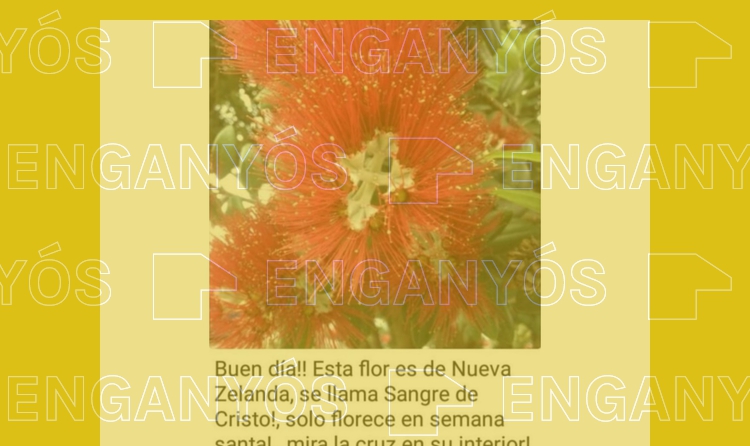Flower known as “Blood of Jesus” exists outside of New Zealand and blooms several times a year

We analyze an image that claims that the flower “Blood of Jesus” is from New Zealand and only blooms during Holy Week

You sent us an image via our WhatsApp service claiming that a flower known as the Blood of Jesus is originally from New Zealand and only blooms during Holy Week. It is MISLEADING. It is true that the tree, Metrosideros excelsa, is originally from the islands of New Zealand and that its flower is popularly known in some countries as the Blood of Jesus due to its colour and the cross-like shape its flower stalks can exhibit. However, it does not only bloom during Holy Week, a Catholic holiday that celebrates the resurrection of Jesus Christ. In fact, there are a number of flowers that go by the name Blood of Jesus.
This flower is from New Zealand – it’s called Blood of Jesus! It only blooms during Holy Week!
The flower that we see in the image you sent us comes from the evergreen tree, Metrosideros excelsa, a species commonly known as “pohutukawa”. One article that reviews its biology and ecology explains that “when flowering, trees are laden with red brush flowers that yield copious amounts of nectar”, which are the “Blood of Jesus” flowers mentioned in the message.
A link between the flower and religion has been made, but “the cross shape (…) has nothing to do with Christ or any religious story. This plant evolved hundreds of millions of years before Christ. It’s merely the appearance of the flower stalks, and it’s not always so easy to see the shape of a cross”, explains Laia Guardia, professor in the Botany department of the Autonomous University of Barcelona, to Verificat.
The South African National Biodiversity Institute (SANBI) explains that “the three is native to New Zealand and Australia and is invasive in Japan, Spain, England, Ireland and South Africa”, although the Spanish Ministry for the Ecological Transition and Demographic Challenge (Ministerio por la Transición Ecológica y el Reto Demográfico, or “Miteco”) does not include it in its list of invasive alien species. It can currently be found in a multitude of places, and not only in New Zealand. As Guardia explains, it is “distributed all over the world, predominately in regions with a Mediterranean climate, as an ornamental.”
Flowering period
The article that reviews the basic characteristics of the pohutukawa also explains that mass flowering occurs from December to January. In fact, as the text points out, “it’s commonly called New Zealand Christmas tree, as the flowering period coincides with Christmas”. Guardia observes that “it is not true that it only flowers during Holy Week. It’s possible that the flowering period in more northerly latitudes is delayed and therefore coincides with Holy Week, but that’s not how it is in its country of origin or in similar latitudes”.
Jordina Belmonte (Spanish only), researcher at the Institute of Environmental Science and Technology (Instituto de Ciencia y Tecnología Ambientales, or ICTA-UAB) and president of the Catalan Institution for Natural History (Institución Catalana de Historia Natural, or ICHN), concurs with Guardia, explaining to Verificat that, in Catalonia, “it is in bloom for several months of the year”.